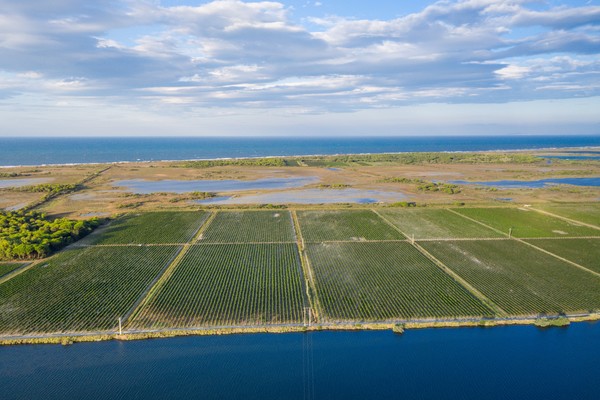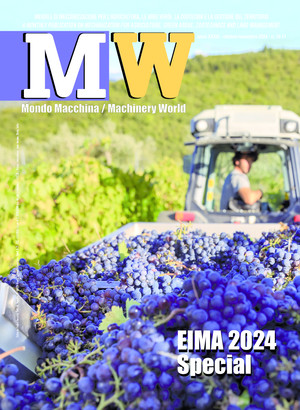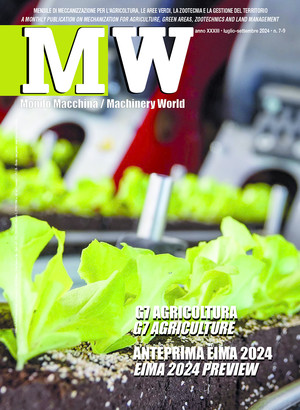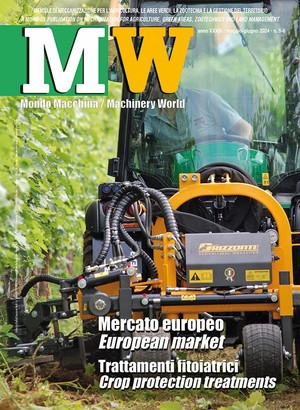
Brackish soils cultivation
Careful varietal selection, proper irrigation and a number of specific techniques make it possible to profitably cultivate even soils with high salt content and brackish water. Soil salinity can compromise the functionality of agricultural machinery
Irrigation is essential for intensive crop production. Moreover, in some agricultural districts, the only option to meet these production needs is to use brackish waters, that is, waters with higher than average salt concentrations, as is often the case in marine and/or arid riparian areas.
Available as open water, in reservoirs or even in the water table, brackish waters are characterized by salt concentrations of up to 3 percent, which often prove to be limiting (if not phytotoxic) for many crops. Such criticality may have a natural origin, such as proximity to the sea and thus "contamination" of fresh waters, or it may be traced to excess salts in the soil and/or from excessive mineral fertilizer inputs.
Excessive salinization can be potentially fatal to crops, as it causes plant dehydration due to the osmotic effect. Therefore, the cultivation of species tolerant to salt stress, such as tomato, beet, barley, asparagus, and spinach, must be considered. On the other hand, soybean, rice, corn and some vegetable and forage species turn out to be moderately sensitive. Conversely, beans, lettuce, orange and peach trees do not tolerate high salt concentrations in water.
Due to the progressive shortage of usable fresh water for non-food purposes, salty water is playing an increasingly important role in the irrigation management of many crops. At the soil level, to mitigate excessive salinity, an adequate supply of soil conditioners, such as composting mature manure or resorting to other suitable solutions, such as green manure, can be considered. Not only from a chemical point of view but also from a physical point of view, soil conditioners bring benefits by improving soil structure, increasing its water retention capacity (including rainwater), and improving biological activity.
Water management. Along with careful soil management, it is vital to identify the best watering system. In such a case, drip irrigation, especially sub-surface irrigation, is particularly advantageous when using brackish water, as it minimizes evaporation, maintains root moisture and limits the possible damage that salt could cause to the leaf apparatus of plants. It is particularly advantageous for this purpose to continuously monitor, through sensors, the characteristics and concentrations of salt in the different watersheds. A more incisive action is undoubtedly obtained with water desalination by osmosis; however, in addition to being very costly for the equipment to be installed, it is also not very sustainable from an energy point of view.
Agronomic techniques. In this regard, direct action can be taken on the plant and manage the microclimate of greenhouse cultivation. Mulching reduces the evaporation of water in the soil, which, therefore, remains in greater quantity available to the crop. At the same time, shading can be used, with a cover of the protected arrangements to limit direct sunlight illumination, taking care, of course, to ensure proper photosynthesis of the crop.
Damage to machinery. Among the many challenges imposed by cultivating brackish soils is to include corrosion (but also surface erosion) of mechanical equipment that is constructed, in whole or in part, of metal. This applies particularly to machinery, both driving and operating, used for tilling.
If steel is involved, the material of choice in this regard is stainless steel, but the cost (and, upstream, the processing difficulties) of stainless steel is a major obstacle to its widespread use. A less costly alternative may be the adoption of protective surface treatments, again of steel, such as galvanizing. Similarly (or in addition), a very common treatment to improve salt resistance is painting and/or coating with protective films. These are viable options, subject to timely maintenance over time, as all surface treatments are subject to decay. It is important to systematically remove salt residues and other contaminants by regularly lubricating moving parts and systematically detecting any initial signs of corrosion. Corrosion inhibitors can offer additional protection, especially in the case of components that are more vulnerable or difficult to treat by other methods. The design and shapes of metal parts can also help make the harmful effect of salty water less impactful. Boxed structures, together with the ones with particularly complex conformations and/or with sharp edges, gaps, and depressions, are prone to water stagnation and more difficult to clean or dry, even if only by simple evaporation.
Soil salinity
Salts interfere with membrane permeability, enzymatic and hormonal activities and, in general, with plant species' cellular biochemical processes. The assessment of soil salinity is carried out indirectly by measuring the electrical conductivity of the solution in equilibrium with the soil since there is a certain proportionality relationship between the two parameters.
More specifically, when the amount of soluble salts (sulfates, chlorides, and bicarbonates of sodium, potassium, calcium, and magnesium) leads the conductivity to exceed the limit of 4 dS/m (decisiemens per meter) the soil is classified as saline. Sodium and chlorides are more harmful than sulfates, while boron is harmful, already above concentrations of 1 ppm. Saline or brackish soils have pHs between 7.1 and 8.5, which is a value tolerated by various plant species.
Salinity is accentuated where rainfall is not sufficient to drain the salts contained in the soil and the presence of shallow aquifers because the water, with upward movement, retracts the salts to the surface. Secondary salinization is also found in irrigated soils, especially with the input of unsuitable water: for example, using "soft" water with 0.5 percent salts for volumes of 4-5000 m³/ha per year contributes 2-2.5 t/ha of salts to the soil.
Early indicators of salinization of agricultural soil involve physiological drying and lack of vigor in plants, reduced yields, and proliferation of salinity-tolerant plants. In arid or semi-arid areas, as soil moisture increases, there is a decrease in soil bearing capacity under the weight of machinery, with increased compaction due to deterioration of the physical soil structure. Further signs of severe and obvious salinization are the appearance of whitish surface areas or stripes or even a true crust.








